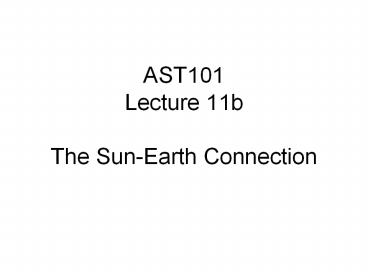AST101 Lecture 11b The Sun-Earth Connection - PowerPoint PPT Presentation
1 / 22
Title:
AST101 Lecture 11b The Sun-Earth Connection
Description:
AST101 Lecture 11b The Sun-Earth Connection The Temperature of the Earth The Earth is in equilibrium with the Sun - on average it is neither heating nor cooling. – PowerPoint PPT presentation
Number of Views:116
Avg rating:3.0/5.0
Title: AST101 Lecture 11b The Sun-Earth Connection
1
AST101Lecture 11bThe Sun-Earth Connection
2
The Temperature of the Earth
- The Earth is in equilibrium with the Sun - on
average it is neither heating nor cooling. - The equilibrium temperature is set by equating
- the heat absorbed from the Sun with
- the heat radiated by the Earth.
- Heat in heat out
3
Heat In
- Energy input comes from the Sun
- (internal heat is negligible)
- The Solar brightness L? / 4p d2 (solar
constant) - L? is the solar luminosity
- d is the distance from the Earth to the Sun, 1AU
- The solar constant is 1.4 x 106 erg/cm2/s, or
1400 W/m2/s.
4
Heat Out
- Approximate the Earth as a blackbody.
- Output LE 4pr2sTE4 (Stefan-Boltzmann law)
- Input Lin A pr2 (L? / 4p d2)
- A albedo fraction of light reflected back to
space (0.39) - pr2 area of Earth intercepting sunlight
5
Balance
- Earth is in equilibrium
- Output input
- (if not, the mean temperature would change)
- LE Lin
- 4pr2sTE4 A pr2 L? / 4p d2
- Solve for TE.
- For the Earth, TE 247K
- In general, T (L/d2)1/4
6
Earth is Not a Blackbody
7
Greenhouse Effect
- In equilibrium, TE 247K
- In actuality, TE 287K (14C)
- The 40K difference is due to the greenhouse
effect. - At 247K, the Earth tries to radiate in the IR
(Wien s law) - The atmosphere is not transparent in the IR
- ? Heat is trapped
8
Greenhouse Effect
- The blackbody is the most efficient radiator
possible - The Earth is not exactly a blackbody
- It must heat up to compensate
- Greenhouse gasses include
- carbon dioxide
- Methane
- water vapor
- nitrous oxide
- chlorofluorocarbons,
- These all absorb infrared light.
9
Equilibrium
- Other things being equal, the
- Greenhouse Effect (GHE)
- keeps the Earth in equilibrium, but at a hotter
temperature than in the absence of the GHE. - Is the Earth in equilibrium?
10
Equilibrium
- Is the Earth in equilibrium?
- There has been liquid water on Earth for at least
3.8 billion years - The surface temperature has been between 273 and
373 K. - Fossils suggest a much narrower range
11
- Washington Post 1/12/11 2010 ties 2005 as
warmest year on record, researchers say - ABC News 12/8/09 Climate 2009 Caps Hottest
Decade on Record - ABC News 1/21/10 Climate Change 2009 Second
Warmest Year on Record
12
2012
- The globally-averaged temperature for 2012 marked
the 10th warmest year since record keeping began
in 1880. It also marked the 36th consecutive year
with a global temperature above the 20th century
average. The last below-average annual
temperature was 1976. Including 2012, all 12
years to date in the 21st century (20012012)
rank among the 14 warmest in the 133-year period
of record. (NOAA)
13
Global Temperatures, 1880 - 2012
Source http//www.ncdc.noaa.gov/sotc/global/
14
Mean global temperature, 700 - 2000 CE
Source http//www.ncdc.noaa.gov/img/climate/globa
lwarming
15
Change in mean sea level since 1870
Source http//www.ncdc.noaa.gov/img/climate/globa
lwarming
16
Predicted global temperatures in the next century
Source http//www.ncdc.noaa.gov/img/climate/globa
lwarming
17
What Causes Global Warming?
18
Solar Irradiance?
19
(No Transcript)
20
Human Activities?
21
(No Transcript)
22
State of the Climate 2011
- http//www.ncdc.noaa.gov/bams-state-of-the-climate
/2011.php































